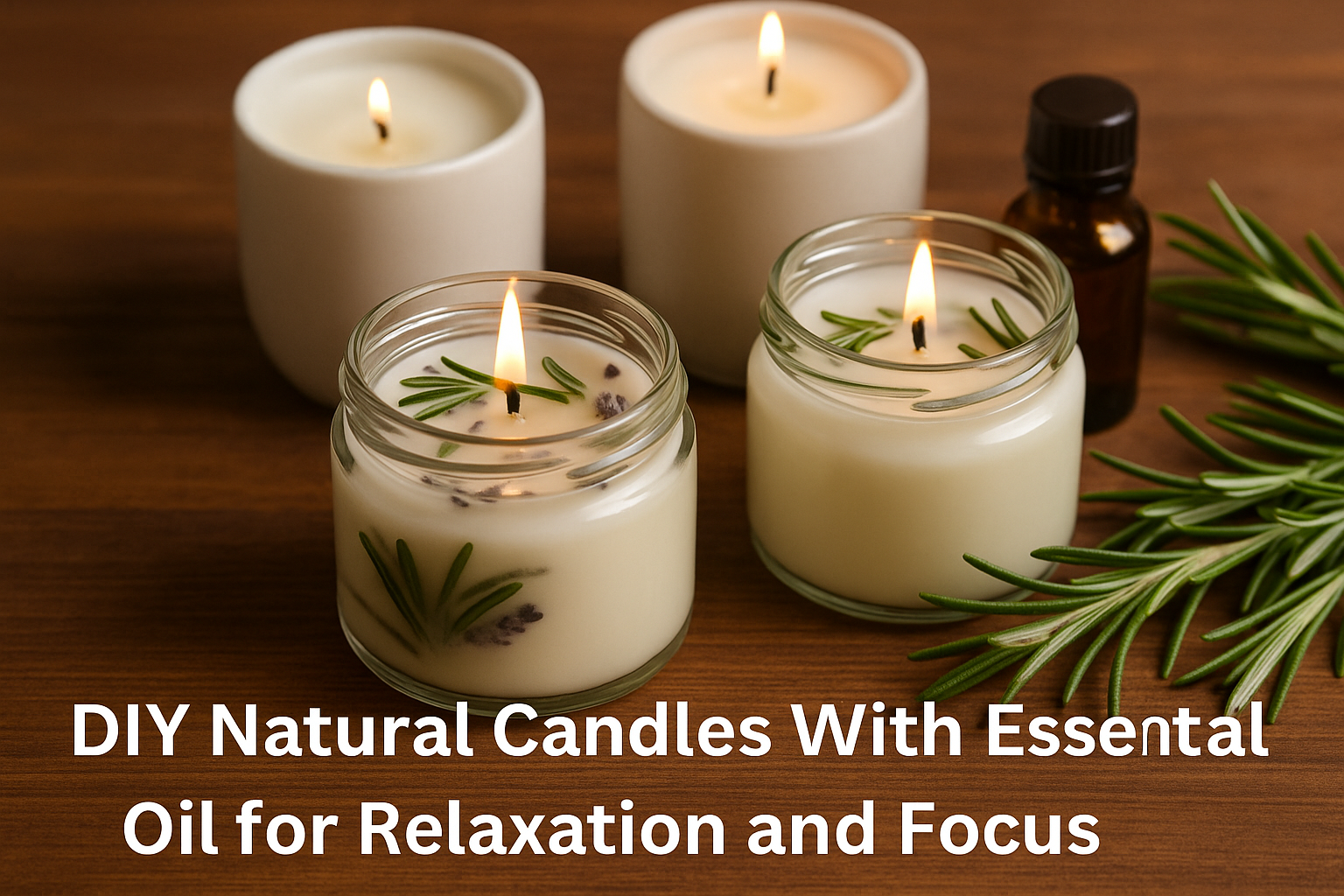Candles are more than light sources. They create atmosphere, mark transitions, and carry meaning. A single flame can calm the mind, focus attention, or transform a room into a sanctuary.
Yet most commercial candles are made with paraffin, synthetic fragrances, and dyes that release pollutants into the air. Instead of bringing comfort, they often contribute to headaches, allergies, or poor indoor air quality.
Homemade DIY natural candles offer a healthier and more meaningful option. By choosing natural waxes, cotton or wooden wicks, and pure essential oils, you can design candles that support relaxation, sharpen focus, and align with cultural traditions.
Making candles at home is not complicated. With basic tools and thoughtful blends, you can produce creations that are safer, sustainable, and personal.
This guide will show in detail how to make natural candles, explore the science of essential oils, explain traditional uses of herbs in candles, and present recipes for relaxation and focus. You will also find tips for decoration, safety, and designing daily rituals with candles.
Why make natural candles at home
Homemade candles burn cleaner than paraffin and avoid toxic additives. They allow you to customize fragrance strength, create blends that fit your emotional needs, and reconnect with cultural practices. They are also more sustainable because jars can be reused, and wax scraps can be remelted.
From an economic perspective, they are cost-effective. A bag of soy wax and a few essential oils can produce dozens of candles. From an emotional perspective, the act of melting, pouring, and waiting becomes a ritual itself, teaching patience and creativity.
Understanding natural candle ingredients
Waxes
- Soy wax: renewable, biodegradable, and burns slower than paraffin.
- Beeswax: purifies the air as it burns, releasing negative ions that neutralize dust and odors. It carries a natural honey aroma.
- Coconut wax: creamy and sustainable, often blended with soy for smoother texture.
- Palm wax: natural but less sustainable unless certified.
Wicks
- Cotton wicks: reliable, burn evenly, and are widely available.
- Wooden wicks: create soft crackling sounds that enhance atmosphere.
- Choosing wick size: too small leads to tunneling, too large produces smoke. Match wick to jar diameter.
Essential oils
Essential oils are volatile plant compounds that evaporate easily when heated. They are responsible for fragrance and therapeutic effects. Rosemary sharpens memory, lavender calms, citrus uplifts, marcela soothes, sage cleanses. The key is to balance strength and compatibility.
Containers
Glass jars, ceramic mugs, or metal tins are ideal. They must withstand heat and be free of cracks. Reused jars add sustainability.
Optional decorations
Dried herbs, citrus slices, or flower petals can be embedded for beauty. These must be placed away from the wick to avoid fire risks.
Tools you need
- Double boiler or heat-safe bowl for melting wax
- Thermometer to monitor temperature
- Measuring cups for accuracy
- Wooden sticks or clips to hold wicks in place
- Heat-resistant containers for candles
Science of scent and mood
Scent has a direct pathway to the brain’s limbic system, which governs memory and emotions. That is why aromas can instantly relax, energize, or focus. Essential oils add therapeutic depth to candles, transforming them into tools for emotional health.
Oils for relaxation
- Lavender: reduces stress and anxiety
- Marcela: traditional Gaúcho herb for calm and renewal
- Chamomile: soft and soothing
- Orange: uplifts while calming
- Sage: clears heavy energy
Oils for focus
- Rosemary: sharpens memory and concentration
- Peppermint: energizes and refreshes
- Lemon: brightens and improves clarity
- Carqueja: grounding and steadying
- Basil: stimulates creative flow
Step-by-step guide to making candles
- Measure wax: about 100 g per small jar.
- Melt wax: heat slowly in double boiler until it reaches 75°C.
- Prepare jars: place wick in center and secure with clip.
- Cool slightly: allow wax to cool to around 60°C before adding oils.
- Add essential oils: about 20–30 drops per 100 g wax for strong scent.
- Stir gently: mix oils evenly without creating bubbles.
- Pour wax: fill jars slowly to avoid spills.
- Let set: cool for 24 hours before trimming wick and lighting.
Recipes for relaxation
Calm Evening Candle
- 100 g soy wax
- 10 drops marcela oil
- 8 drops lavender oil
- 6 drops orange oil
Stress Relief Candle
- 100 g soy wax
- 12 drops lavender
- 6 drops sage
- 4 drops guaco
Sleep Support Candle
- 100 g soy wax
- 10 drops chamomile
- 8 drops marcela
- 4 drops sandalwood
Winter Comfort Candle
- 100 g beeswax
- 6 drops cinnamon
- 8 drops orange
- 6 drops marcela
Recipes for focus
Morning Clarity Candle
- 100 g soy wax
- 10 drops rosemary
- 6 drops lemon
- 4 drops peppermint
Study Aid Candle
- 100 g soy wax
- 8 drops rosemary
- 6 drops carqueja
- 4 drops guaco
Work Energy Candle
- 100 g soy wax
- 10 drops citrus blend (orange + lemon)
- 6 drops rosemary
Creative Flow Candle
- 100 g soy wax
- 8 drops orange
- 6 drops basil
- 4 drops lavender
Decorating candles naturally
Adding herbs or citrus slices gives candles beauty and symbolism. Rosemary sprigs represent clarity, marcela flowers symbolize renewal, orange slices add cheer. Always keep decorations far from the wick to prevent flames from catching them.
Traditional roots of candle rituals
Lighting a candle has always been symbolic. In Gaúcho homes, herbs were burned or infused to cleanse and protect. By embedding these same herbs into candles, you continue traditions with modern tools. The flame carries both light and fragrance, linking past rituals to present well-being.
How to use candles in daily life
Morning routine
Light a rosemary-lemon candle while preparing breakfast. The sharp aroma clears mental fog.
Afternoon focus
Burn a peppermint-rosemary candle while studying or working. Helps sustain attention.
Evening calm
Use marcela-lavender candles one hour before sleep. They calm the nervous system and create ritual closure.
Weekly renewal
On Sundays, light a sage-rosemary candle to symbolically cleanse the week’s heavy energy.
Seasonal adjustments
- Spring: lemon, mint, rosemary
- Summer: citrus blends with boldinho
- Autumn: orange, cinnamon, guaco
- Winter: marcela, sage, lavender
Safety tips
- Do not add oils while wax is above 65°C, or they will evaporate.
- Trim wicks to 5 mm before lighting.
- Do not leave candles unattended.
- Do not burn more than 4 hours at a time.
- Store candles in cool places away from direct sunlight.
Mistakes to avoid
- Using too much oil: can cause uneven burning.
- Ignoring wick size: leads to tunneling or excess smoke.
- Adding decorations near flame: risk of fire.
- Skipping curing: candles need 24 hours before lighting.
- Expecting strong artificial fragrance: natural candles are subtler but healthier.
Long-term benefits of DIY candles
Homemade candles reduce exposure to synthetic toxins. They create opportunities for creativity and relaxation. They make excellent sustainable gifts. They help preserve cultural heritage by integrating traditional herbs like marcela and rosemary into modern rituals. Most importantly, they support emotional health by turning fragrance into active self-care.
Conclusion
DIY natural candles with essential oils are safe, customizable, and deeply meaningful. They transform simple light into a tool for relaxation, focus, and cultural continuity.
By choosing soy or beeswax, natural wicks, and essential oils like rosemary, marcela, and citrus, you create candles that heal both air and spirit.
Homemade candles burn cleaner, save money, and connect you to heritage. Each flame becomes more than light. It becomes a ritual of care, clarity, and renewal.

Marcela Cardozo is passionate about Southern Brazilian traditions and the cultural stories carried through natural scents. She blends knowledge of native herbs, essential oils, and regional rituals to create practical and inspiring content. Her writing connects ancestral wisdom with modern living, offering readers simple ways to bring authenticity, well-being, and meaning into their everyday lives.
